
Hoverflies, also called flower flies or syrphids, make up the insect family Syrphidae. As their common name suggests, they are often seen hovering or nectaring at flowers; the adults of many species feed mainly on nectar and pollen, while the larvae (maggots) eat a wide range of foods. In some species, the larvae are saprotrophs, eating decaying plant and animal matter in the soil or in ponds and streams. In other species, the larvae are insectivores and prey on aphids, thrips, and other plant-sucking insects.
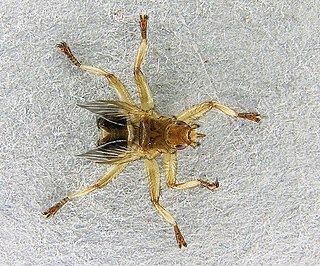
Hippoboscidae, the louse flies or keds, are obligate parasites of mammals and birds. In this family, the winged species can fly at least reasonably well, though others with vestigial or no wings are flightless and highly apomorphic. As usual in their superfamily Hippoboscoidea, most of the larval development takes place within the mother's body, and pupation occurs almost immediately.

Andrena is a genus of bees in the family Andrenidae. With over 1,500 species, it is one of the largest genera of animals. It is a strongly monophyletic group that is difficult to split into more manageable divisions; currently, Andrena is organized into 104 subgenera. It is nearly worldwide in distribution, with the notable exceptions of Oceania and South America. Bees in this genus are commonly known as mining bees due to their ground-nesting lifestyle.

Lejops is a genus of hoverflies, closely related to the genera Helophilus, Quichuana and Mallota.
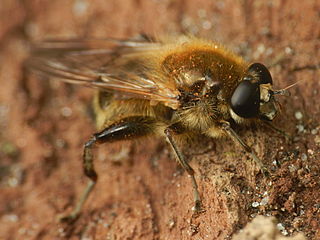
Brachypalpus is a genus of hoverflies, from the family Syrphidae, in the order Diptera. The head is triangular and produced well forwards and somewhat downwards. The thorax and abdomen with pile often rather long. The hind femur is swollen and with an obtuse spur apically and ventrally. The hind trochanters of male is spurred.
The larvae are of the rat-tailed type feeding on decaying sap under tree bark. Larvae live in decaying trees and logs. Larva and pupa have been described by Malloch.

Pterallastes is a genus of bee-mimicking hoverflies. So far the genus contains only two species, one in North America and one from the Sichuan province of China.
Lejops chrysostomus is the former name for a species of syrphid fly which is now called Anasimyia chrysostoma. The old name is still sometimes used for the species.
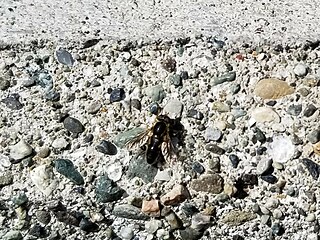
Anasimyia perfidiosus is a species of syrphid fly in the family Syrphidae, found in North America.
Lejota is a genus of syrphid flies in the family Syrphidae.

Asemosyrphus polygrammus, the common sickleleg, is a species of rat-tail maggot fly in the family Syrphidae.
Sphegina californica is a species of hoverfly in the family Syrphidae.
Sphegina rufa is a species of hoverfly in the family Syrphidae.
Sphegina bridwelli is a species of hoverfly in the family Syrphidae.

Sphegina infuscata is a species of hoverfly in the family Syrphidae.
Brachyopa rufiabdominalis , the Red-tailed Sapeater, is a rare species of syrphid fly. It has been observed in Colorado. Hoverflies get their names from the ability to remain nearly motionless while in flight. The adults are also known as flower flies, for they are commonly found around and on flowers from which they get both energy-giving nectar and protein-rich pollen. Larvae for this genus are of the rat-tailed type. B.rufiabdominalis larvae have not been described.
Arctosyrphus is a genus of rat-tail maggot flies in the family Syrphidae. This genus has a single species, Arctosyrphus willingii. It was formerly a member of the genus Lejops.
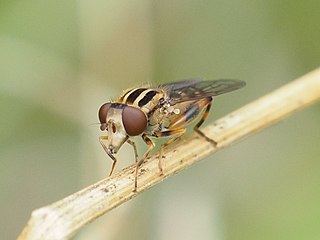
Eurimyia is a genus of rat-tail maggot flies in the family Syrphidae. There are three described species in Eurimyia. They were formerly members of the genus Lejops.
Lunomyia is a genus of rat-tail maggot flies in the family Syrphidae. This genus has a single species, Lunomyia cooleyi. It was formerly a member of the genus Lejops.
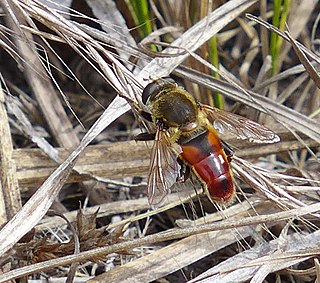
Polydontomyia is a genus of rat-tail maggot flies in the family Syrphidae. The genus is monotypic, comprising a single species, Polydontomyia curvipes, also known as the dimorphic sickleleg. It was formerly a member of the genus Lejops.

Helophilina is a subtribe of rat-tail maggot flies in the family Syrphidae. There are about 19 genera and more than 180 described species in Helophilina.












